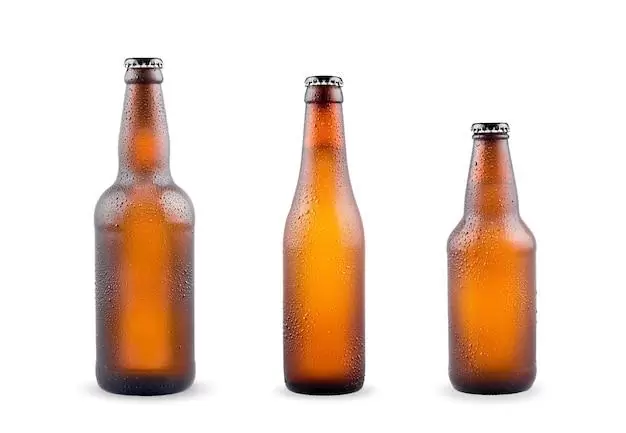Glass Bottle Sizes: A Complete Guide
Are you a lover of glass bottles? Whether you’re a DIY enthusiast, a homebrewer, or a packaging professional, understanding glass bottle sizes is essential. That’s why we’ve created a complete guide to help you navigate the various dimensions and capacities available.
In this comprehensive article, we’ll walk you through the most common glass bottle sizes and their uses. From mini bottles perfect for individual servings to large containers for storing bulk liquids, we’ve got you covered.
Common Glass Bottle Sizes and Their Uses
Glass bottle sizes come in a wide range of options to suit different purposes. Let’s start with the most common sizes and their uses.
1. Mini Bottles (1 oz – 2 oz): Mini glass bottles are ideal for samples, travel-sized products, and crafts. They are often used for essential oils, perfumes, and other small quantities of liquids. Their compact size makes them convenient for on-the-go use.
2. Small Bottles (4 oz – 8 oz): Small glass bottles are versatile and can be used for a variety of purposes. They are commonly used for condiments, sauces, and homemade beauty products. Their compact size and wide range of closures make them a popular choice for many applications.
3. Medium Bottles (12 oz – 16 oz): Medium-sized glass bottles are often used for beverages, such as juices, kombucha, and craft beers. They provide enough capacity for individual servings while still being manageable to hold. These bottles are also commonly used for storing homemade sauces and dressings.
4. Large Bottles (32 oz – 64 oz): Large glass bottles are perfect for storing bulk liquids. They are commonly used for storing homemade wines, spirits, and bulk quantities of beverages. These bottles are also popular in the culinary industry for storing oils, vinegars, and other ingredients.
5. Specialty Bottles: In addition to the standard sizes mentioned above, there are specialty glass bottle sizes that cater to specific needs. These include slim bottles for olive oil, swing-top bottles for carbonated beverages, and gallon-sized jugs for industrial use.
Factors to Consider When Choosing Glass Bottle Sizes
When choosing the right glass bottle size for your needs, there are several factors to consider. These factors will ensure that the bottle meets your requirements and provides a seamless experience for your customers.
1. Product Type and Quantity: Consider the type of product you are packaging and the quantity you need. For example, if you are selling a high-demand beverage, you may want to opt for larger bottle sizes to accommodate bulk orders.
2. Shelf Space and Storage: Evaluate the available shelf space in your store or storage area. Different bottle sizes require different amounts of space. Ensure that you have enough room to store your products efficiently without overcrowding.
3. Cost and Budget: Glass bottle sizes vary in price, with larger sizes generally costing more. Consider your budget and the value proposition of your product when choosing the size. It’s essential to strike a balance between cost-effectiveness and meeting your customers’ needs.
4. Branding and Packaging: Your glass bottle size should align with your branding and packaging strategy. Consider the visual appeal of the bottle, the label size, and how it fits into your overall brand image. A well-designed bottle can attract customers and enhance brand recognition.
Glass Bottle Size Conversions
Converting between different glass bottle sizes can be tricky, especially if you are working with international suppliers or need to adjust your recipes. Here are some common glass bottle size conversions to help you navigate this process.
1. Ounces to Milliliters: To convert ounces to milliliters, multiply the number of ounces by 29.5735. For example, 8 ounces is approximately equal to 237 milliliters.
2. Milliliters to Ounces: To convert milliliters to ounces, divide the number of milliliters by 29.5735. For example, 500 milliliters is approximately equal to 16.91 ounces.
3. Gallons to Liters: To convert gallons to liters, multiply the number of gallons by 3.78541. For example, 1 gallon is approximately equal to 3.785 liters.
4. Liters to Gallons: To convert liters to gallons, divide the number of liters by 3.78541. For example, 10 liters is approximately equal to 2.64 gallons.
Keep these conversions handy when working with suppliers or adjusting your recipes to ensure accuracy and consistency.
Popular Industries That Use Specific Glass Bottle Sizes
Various industries rely on specific glass bottle sizes to meet their unique needs. Here are some popular industries and the glass bottle sizes commonly used within them.
1. Food and Beverage: The food and beverage industry often uses a range of glass bottle sizes, from small condiment bottles to larger beverage containers. This includes products such as sauces, dressings, oils, juices, wines, and spirits.
2. Cosmetics and Personal Care: Glass bottles are popular in the cosmetics and personal care industry due to their aesthetic appeal and ability to preserve the integrity of the products. Common sizes used in this industry include small bottles for perfumes and serums, as well as larger bottles for lotions and creams.
3. Pharmaceuticals: The pharmaceutical industry relies on glass bottles for storing medications, vitamins, and supplements. These bottles come in various sizes, depending on the type of product and dosage requirements.
4. Homebrewing and Craft Beverages: Homebrewers and craft beverage enthusiasts often use glass bottles to store their creations. This includes beer bottles in standard sizes like 12 oz and 22 oz, as well as specialty sizes for unique brews.
Advantages and Disadvantages of Different Glass Bottle Sizes
Each glass bottle size has its advantages and disadvantages. Understanding these can help you make an informed decision when selecting the right size for your needs.
1. Advantages:
- Small bottles are portable, convenient, and suitable for individual servings.
- Large bottles are ideal for storing bulk liquids and are cost-effective for high-demand products.
- Specialty bottles cater to specific needs and can enhance the presentation of your products.
- Glass bottles are reusable, recyclable, and offer excellent product protection.
2. Disadvantages:
- Small bottles may not be suitable for products with high demand or bulk orders.
- Large bottles may be too heavy or cumbersome for individual use.
- Specialty bottles may have limited availability or higher costs.
- Glass bottles can be fragile and require careful handling to prevent breakage.
Consider these advantages and disadvantages in relation to your specific needs to make an informed decision when choosing glass bottle sizes.
How to Properly Measure Glass Bottle Sizes
Properly measuring glass bottle sizes is essential to ensure accuracy when ordering or using them. Here’s a step-by-step guide on how to measure glass bottle sizes correctly.
1. Height: Measure the height of the bottle from the base to the top of the neck. Ensure that you measure the actual glass portion and exclude any closures or caps.
2. Diameter: Measure the diameter of the bottle at its widest point. This is usually the base or the shoulder of the bottle.
3. Neck Finish: The neck finish refers to the size and type of closure that fits the bottle. Measure the outer diameter of the bottle’s neck to determine the neck finish size.
By accurately measuring the height, diameter, and neck finish of a glass bottle, you can ensure a proper fit for closures and make informed purchasing decisions.
Tips for Storing and Organizing Glass Bottles of Different Sizes
Storing and organizing glass bottles of different sizes can be a challenge, especially if you have a large inventory. Here are some tips to help you keep your glass bottles organized and prevent breakage.
1. Use Shelving Units: Invest in sturdy shelving units that can accommodate your bottle sizes. Ensure that the shelves are properly spaced to prevent bottles from toppling over.
2. Group by Size and Type: Organize your glass bottles by size and type to make it easier to locate specific bottles when needed. This can be done by assigning dedicated shelves or sections for each size or type.
3. Implement Protective Measures: Use dividers, foam inserts, or cardboard separators to create individual compartments for each bottle. This will help prevent bottles from clinking together and potentially breaking.
4. Label and Track Inventory: Label each shelf or section with the corresponding bottle size or type. Implement an inventory tracking system to keep track of stock levels and ensure timely restocking.
By following these tips, you can efficiently store and organize your glass bottles, reducing the risk of breakage and making it easier to manage your inventory.
Sustainable Packaging Options Using Glass Bottle Sizes
Glass bottles offer numerous sustainable packaging options compared to other materials like plastic. Here are some ways you can embrace sustainability using glass bottle sizes.
1. Reusability: Glass bottles can be reused multiple times, reducing the need for single-use packaging. Encourage customers to return their empty glass bottles for refilling or offer incentives for recycling.
2. Recyclability: Glass is highly recyclable, and the recycling process uses less energy compared to manufacturing new glass. Promote the recyclability of your glass bottles to encourage customers to dispose of them responsibly.
3. Eco-Friendly Materials: Consider using eco-friendly materials for closures, such as cork or bamboo, to further enhance the sustainability of your packaging.
4. Transparent Supply Chain: Communicate your commitment to sustainability by providing transparency about your supply chain. This includes sourcing glass bottles from manufacturers with sustainable practices and using eco-friendly production methods.
By prioritizing sustainability in your packaging choices, you can attract environmentally conscious customers and contribute to a greener future.
Conclusion: Choosing the Right Glass Bottle Size for Your Needs
Selecting the right glass bottle size is crucial for a seamless packaging experience and meeting your customers’ needs. Consider factors such as product type, storage space, budget, and branding when making your decision.
Remember to measure glass bottle sizes accurately, organize and store them properly, and embrace sustainable packaging practices. With the knowledge gained from this complete guide, you are well-equipped to make informed decisions and unlock the world of glass bottle sizes.
So, whether you’re a DIY enthusiast, a homebrewer, or a packaging professional, explore the different glass bottle sizes available and choose the one that best suits your needs. Cheers to finding the perfect glass bottle size!






